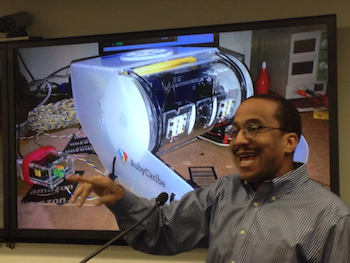31 Jan 2015
If you have ever attended WindyCityRails: Thank you for helping to make the event more exciting every year. Organizers strive to give developers actionable technical information in a conference format. So far, it’s working!
Continue reading →
22 Jan 2015
There are some cases where time zone information is absolutely critical. For example: When scheduling a video conference that crosses national boundaries.
A few hours ago, Google sent me a reminder about today’s LinuxBarbados meeting. The group meets via video conferencing software over the web. Google’s reminder was confusing because it showed the time without the time zone (screenshot below). LinuxBarbados is based in the Caribbean, and members participate from multiple time zones around the world.
Continue reading →
20 Jan 2015
The Chicago Node.js user group invited me to present Node.js Under Water, an overview of the OpenROV underwater robot, this evening. Slides appear below.
Every version of this talk is tailored to the audience. This version focuses on OpenROV hardware components since this group certainly knows Node.js. Information has been added on hardware gotchas and tether management.
Thank you Chicago Node.js organizers and members for having me.
Continue reading →
03 Jan 2015
It is always good to start the new year with something inspirational. Technicon Design created a 3-minute video to demonstrate their IXION Windowless Jet Concept. Worth watching full screen.
How can a plane with no windows offer better views for passengers?
Continue reading →
31 Dec 2014
This blog uses pygments.rb for syntax highlighting. Recently pygments.rb stopped working, so I had to dig inside to determine the problem and apply a solution.
Full disclosure: Pygments didn’t simply stop working. I applied updates related to Octopress and lunr.js, and then it stopped working. So the root cause is me! Rather than back-out the updates, I decided to push forward because lunr.js will improve the search experience for visitors. Search options will be discussed in a future post.
Continue reading →




